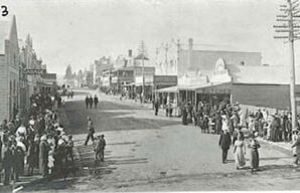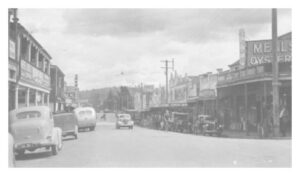Probably the first white man to travel through this part of New South Wales would have been a Mr. W. Clark, the Commercial Agent aboard the trading vessel “Sydney Cove” on route from Bengal to Port Jackson which ran ashore on Preservation Island on the 8th of February 1797. The records show that they were in the Tathra area 3rd to 5th April 1797. Clark and two Lascars were finally rescued on the l4th May by a fishing boat 14 miles south of Botany Bay.
William Tarlington was the first white man to see the fertile Bega Valley. In 1829, with three Aboriginal stockmen, he travelled down the rivers from Braidwood in search of pastures. They explored the Cobargo and Bermagui districts and went on to Bega. In 1832 his cattle were moved from Braidwood to Murrabrine, Cobargo and later to Bredbatoura which he made his home. William Tarlington was closely followed by the Imlay Brothers who were given a huge squattage where they established their homestead, Tarraganda House.
European settlement dates from the 1830s, initially in the Twofold Bay (Eden) and Bega areas.
Squatters moved into the Bega Valley from the inland areas of Monaro and Braidwood and staked out their grazing ‘runs’ in the early 1830s.
In 1834 the Imlay brothers, who acquired over 65,000 acres of runs, arrived and began permanent settlement of the area including the ‘Tarraganda’ run at ‘Biggah’.
Government Surveyor Parkinson laid out a new town at what is now North Bega (on the site of the present Bega Cheese Factory). The origin of the name Bega is not definitive but is probably based on the Aboriginal word ‘Biggah’, which is thought to mean ‘big camping ground’ or ‘beautiful’.
After a disastrous flood In May 1851 the town was moved to higher ground on the southern side of the river where it still stands today. In the first plan, the main street was Auckland Street, hence the construction of substantial buildings along that street. When the town centre moved Carp Street became the main street.
The first town allotments were surveyed in February 1854 and sold at Eden in August of that year. Eden was the only port for communication and transport until Merimbula port was opened in 1855.
In 1858 the Victoria Inn was opened in Auckland Street, and in 1859 the Family Hotel opened on the corner of Bega and Auckland Streets (now the Bega Pioneers’ Museum). Both buildings are still in existence, the Family Hotel is now the Bega Pioneers’ Museum. You can obtain from the Bega Pioneers’ Museum a pamphlet for a Bega Heritage Walk that contains a small map indicating several historic buildings and places.
By 1861 the population of Bega was 625 in 100 households. The Bega district was regarded as one of the few successful areas where land selections under the 1861 Crown Lands Acts facilitated orderly settlement of the lands, with an average consolidated holding up to 500 acres.
Under the Crown Lands Acts, anyone with a small deposit was able to take up Crown land and convert the title to freehold. Men and women with energy and entrepreneurship took up land in the Bega Valley and, with hard work, turned it into profitable farms. The ports of Tathra and Merimbula were relatively close to the farms and this meant that produce could be shipped easily and quickly to Sydney, Melbourne and Tasmania.
The operation of the Crown Land Acts is considered to be largely responsible for the successful development of the dairy industry in the Bega Valley. This success is recorded in the Morris and Rankin Report to Parliament on the State of Public Land in New South Wales (1884) that said:
Bega is one of the most prosperous districts in the colony, and its prosperity is mainly attributable to the fact of the land having been thrown open to the people. Rich land, mild climate, copious and regular rainfall, and last but not least, easy and cheap communication by water with the metropolis, all these stamp it as a locality peculiarly adapted for homestead settlement, and upon which (there can be no question) the legislation of 1861 conferred incalculable benefit….’ Morris and Rankin Report to the New South Wales Government in 1884.
Dairy farming expanded quickly throughout the 1860s, overtaking cattle farming as the predominant industry. In 1858, Tathra was used as a port for the transport of products to Sydney, and the Illawarra Steam Company was established. In 1860, the Tathra Wharf was constructed by the company, which allowed for the further growth and expansion o f the dairy industry.
f the dairy industry.
In the late 1890s the Bega Dairy Co-operative Limited was established. Bega is now well known for its cheese that is manufactured by the Bega Co-operative Society, one of the larger Australian cheese companies. ‘Bega Cheese’ is exported around the world and distributed across Australia and is available in most supermarkets and general stores.
